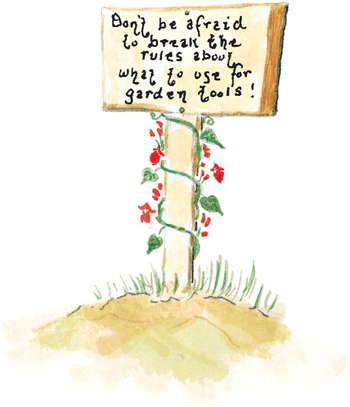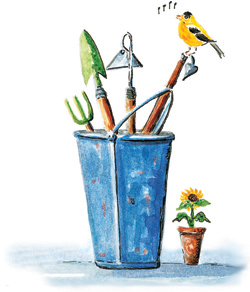
Years ago, I learned that whatever oddball tool or container I wanted to use in the garden was invariably somewhere else, so I determined to outfit my work area with everything I needed, and more. Now my potting shed sports a motley assortment of tools, and more culinary equipment than you’ll find in my kitchen. From the ceiling hang baskets, hanks of raffia, and an array of old galvanized tinware. Shelves bow under the weight of rescued and recycled treasures that now help to simplify and enrich my days in the garden.


Attach a soap dish with soap and a nail brush to the side of your potting bench. Dig your fingernails into the soap before you begin working in the garden.
Old serving pieces—ladles, knives, spoons, and forks—to use as digging and transplanting tools.
Wire whisks or an old egg-beater to whip up your home-brewed bug potions and fertilizers.
A paper-towel dispenser mounted near your work area means you’ll always have towels for quick and easy cleanups.
An apple corer makes a miniature dibber for tiny bulbs like muscari, galanthus, and leucojum.
Kitchen or barbecue tongs for picking up offensive things like slugs and pulling up stinging nettles.
Grapefruit knives, with their sharp, curved blades, make perfect weeders for container gardens. They’re also great for transplanting seedlings.
Long-handled wooden spoons or spatulas for bouncing bugs off plants (see here) and for mixing batches of compost tea, potting soils, and fertilizers.
Attach brass cup hooks to your potting bench for hanging measuring cups and spoons.
Old colanders or laundry baskets for harvesting fruits and vegetables.
Heavy-duty paper clips and clothespins have hundreds of uses in your work area—from sealing opened seed packets to clipping gloves closed as a precaution against spiders.
“The purpose of a garden is to give its owner the best and highest kind of earthly pleasure.”
—Gertrude Jekyll
Hang old Clothespins along a wire. When harvesting herbs, garlic, onions, and flowers, use the pins to sort and clip them into bunches.
Keep a basket of clothespins and pieces of string in your garden for shoring up sagging plants on trellises or giving a climbing vine a little support.
Instead of tossing out that extra wall calendar, take it apart and laminate the page for each month. Attach it (along with a Magic Marker on a string) near your outdoor work area. The more accessible it is, the more you’ll use it. For each month, record daily weather and rainfall, and note when seeds sprout, pests appear, bushes bloom, and vegetables ripen. Save all the pages for reference next year.
Snap photos of plantings and borders in each season and clip them onto your laminated calendar or to pages in your journal. Refer to them to refresh your memory about successful color or plant combinations (and the unsuccessful ones, too).
When faced with the dilemma of what to prune from a tree, take a picture and make a few copies. Then, with correction fluid, block out branches you want to cut and you’ll be able to see exactly how your tree will look.
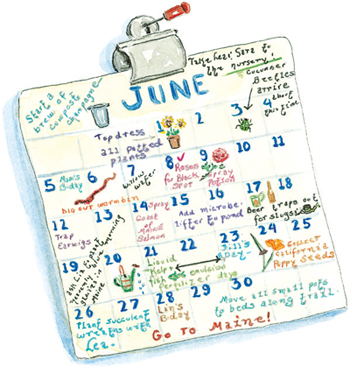
An old calendar lives another year.
Draw a sketch of your yard, and make several copies. Observe your site morning, noon, and afternoon during the growing season, and use colored markers to indicate shady and sunny areas. Clip the charts to your calendar or journal and consult them before planting.
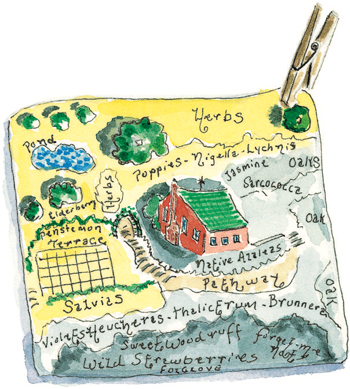
Ask your nursery to save plastic basket-weave flats (18 inches by 18 inches) for you. Use them as compost screeners and as covers to protect emerging seedlings. Or line them with newspaper, fill with soil, and plant your own seedlings in them. They’re also great for drying flowers and herbs.
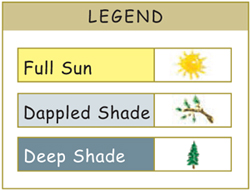
Reading Your Landscape
Recycle those plastics strawberry or tomato baskets as cloches for tender young plants and bulbs or as organizing tools for your seed packets.
Line the little baskets with brown paper bags, newspaper, or paper towels, add soil, and plant them with the seeds of finicky flowers and vegetables that don’t like to be transplanted. Once a set of true leaves (see “True Leaves”) appears, tuck the baskets directly into the ground and the roots will find their way out.
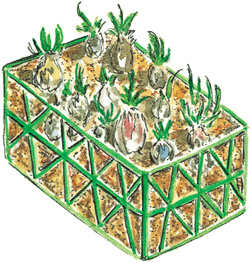
Give new life to mateless or holey, old socks. Cut the foot off and slip the uppers over your wrists to protect your arms from small cuts and your shirts from dirt and damage. They’re especially good when you’re working around berries and roses.
Slip clean socks or nylons over ripening fruits you want to protect from hungry pests. Remember to remove the socks a few days before harvest so the fruit can color.
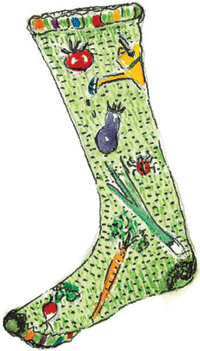
 Transform a holey watering can into a twine dispenser. Remove the watering head, place a ball of twine inside, and draw the twine through the spout. Keep a pair of scissors tied to the handle for easy use.
Transform a holey watering can into a twine dispenser. Remove the watering head, place a ball of twine inside, and draw the twine through the spout. Keep a pair of scissors tied to the handle for easy use.
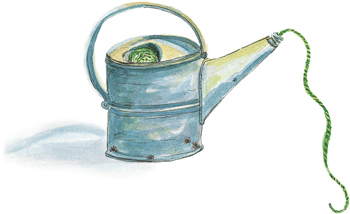
 Keep bunches of long twigs and pea stakes in sand-filled buckets stationed throughout your garden. Use them to trellis or stake your plants and enjoy them as free-form garden sculpture.
Keep bunches of long twigs and pea stakes in sand-filled buckets stationed throughout your garden. Use them to trellis or stake your plants and enjoy them as free-form garden sculpture.
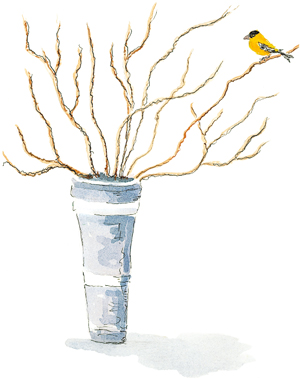
 Store a roll of string inside an upside-down terra-cotta pot and pull the string end through the hole.
Store a roll of string inside an upside-down terra-cotta pot and pull the string end through the hole.
 For a pocket twine dispenser, use a grated-cheese container, and run the twine through a hole in the lid.
For a pocket twine dispenser, use a grated-cheese container, and run the twine through a hole in the lid.
 Hang a role of Velcro tape on a nail. Use the Velcro for quick and easy adjustable tie-ups of vines, shrubs, and veggies.
Hang a role of Velcro tape on a nail. Use the Velcro for quick and easy adjustable tie-ups of vines, shrubs, and veggies.
 Grow your own bamboo plant supports in a large half-barrel filled with potting soil. Check with your local nursery for species that grow well in your area. The running bamboos are hardy and thrive in cramped quarters. You’ll be surprised how quickly a grove will fill a barrel!
Grow your own bamboo plant supports in a large half-barrel filled with potting soil. Check with your local nursery for species that grow well in your area. The running bamboos are hardy and thrive in cramped quarters. You’ll be surprised how quickly a grove will fill a barrel!
 Use concrete reinforcing wire (found in lumber yards) as a trellis or arbor, or bend the wire into the shape of a tunnel. These sturdy and inexpensive supports quickly take on a rusty, antique look that blends beautifully into a garden.
Use concrete reinforcing wire (found in lumber yards) as a trellis or arbor, or bend the wire into the shape of a tunnel. These sturdy and inexpensive supports quickly take on a rusty, antique look that blends beautifully into a garden.
 Inexpensive bushel baskets make rustic planters for potatoes and tomatoes.
Inexpensive bushel baskets make rustic planters for potatoes and tomatoes.
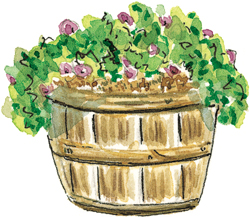
 Commandeer discarded wooden produce boxes (your grocer is usually delighted to give these away) and plant them with mini-vegetables.
Commandeer discarded wooden produce boxes (your grocer is usually delighted to give these away) and plant them with mini-vegetables.
 Use scraps of that ubiquitous bubble wrap to insulate the inside walls of thin plastic and metal plant containers to prevent the harmful buildup of heat. Line the sides of your containers before filling them with soil.
Use scraps of that ubiquitous bubble wrap to insulate the inside walls of thin plastic and metal plant containers to prevent the harmful buildup of heat. Line the sides of your containers before filling them with soil.
 Turn an old wheelbarrow into a movable garden. Plant an ever-changing array of perennials or a medley of herbs, and move it to follow the sun.
Turn an old wheelbarrow into a movable garden. Plant an ever-changing array of perennials or a medley of herbs, and move it to follow the sun.
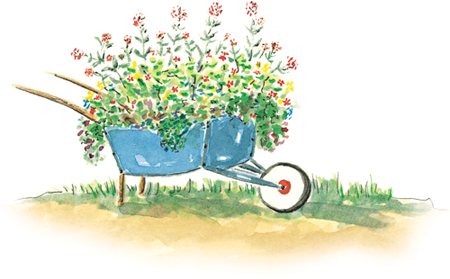
 Create an instant raised planter for espaliered trees and specimen bushes. Remove a few portions of the bottom of an old half-barrel (not all, or the barrel will collapse), and set it in place. Fill the barrel with good soil and compost, and plant your tree. The roots will roam freely once they reach the ground. Fertilize trees monthly.
Create an instant raised planter for espaliered trees and specimen bushes. Remove a few portions of the bottom of an old half-barrel (not all, or the barrel will collapse), and set it in place. Fill the barrel with good soil and compost, and plant your tree. The roots will roam freely once they reach the ground. Fertilize trees monthly.
Cut an old screen or panty hose into small squares and use the squares to cover drainage holes in containers. The screen keeps soil from washing out and critters from getting in. (Slugs, earwigs, and pillbugs can get through pebbles or shards.)
 Stockpile the chopsticks that come with Chinese take-out and use them as dibbers for planting small bulbs.
Stockpile the chopsticks that come with Chinese take-out and use them as dibbers for planting small bulbs.
 Become adept at using chopsticks to pick up slugs and other gross interlopers, and dispose of them in soapy water.
Become adept at using chopsticks to pick up slugs and other gross interlopers, and dispose of them in soapy water.
 Two chopsticks stuck into the ground at an angle act as an anchor for lightweight strawberry basket cloches.
Two chopsticks stuck into the ground at an angle act as an anchor for lightweight strawberry basket cloches.
 Wire copper plant labels to chopsticks and set them firmly in the ground.
Wire copper plant labels to chopsticks and set them firmly in the ground.
 Cut miniblinds or old wooden venetian blinds into short lengths and label them with acrylic paint or a waterproof pen.
Cut miniblinds or old wooden venetian blinds into short lengths and label them with acrylic paint or a waterproof pen.
 Laminate seed packets and then glue them to tongue depressors or Popsicle sticks for informational garden markers.
Laminate seed packets and then glue them to tongue depressors or Popsicle sticks for informational garden markers.
 Old slate roof tiles or contemporary slate floor tiles make enduring markers. Use acrylic paint to print the name, then stick the slate about 2 inches into the ground. Use a masonry blade to cut larger tiles.
Old slate roof tiles or contemporary slate floor tiles make enduring markers. Use acrylic paint to print the name, then stick the slate about 2 inches into the ground. Use a masonry blade to cut larger tiles.
 For tiny labels, write the plant names on tongue depressors.
For tiny labels, write the plant names on tongue depressors.
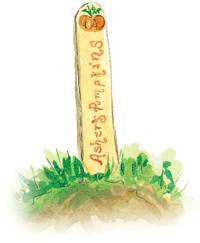
Many French provençal gardeners set old half-barrels throughout their gardens to catch rainwater. The proximity of the barrels to their work areas makes hand-watering with a can easier, and they believe warm water is best for plants.
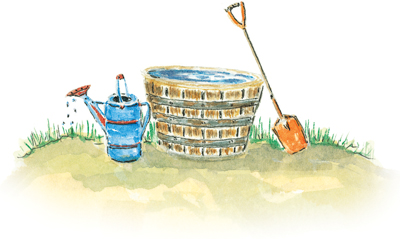
Prop an old wooden ladder (past its prime for safe use) against a wall to serve as a trellis. Plant pumpkins, gourds, or squash at its feet.
Lay an old ladder flat on the ground and fill the spaces between the steps with soil to create raised beds—perfect for herbs, an array of lettuces, or flowers.
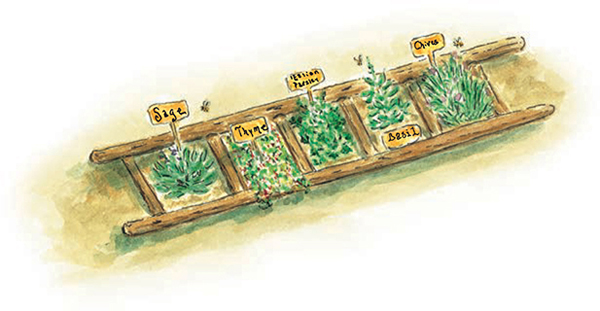
Simple steps to a quick bed.
Plastic and terra-cotta pots turned upside down make great cloches and blanching pots.
Put that snow sled to new use in the spring. Tape a piece of cardboard over the seat, allowing it to hang over the sides. Apply Stickum Goo (see recipe) onto the sides and top of the cardboard. Pull the sled over your beds, straddling your crops of small seedlings. As pests leap out of the way, they get stuck dead in their tracks.

Gardeners can never have too many trash cans in their work areas—they can hold mulch, worm castings, fertilizer, and organic compost teas.
Slip a scrap of foam rubber pipe insulation over tool handles for a better grip.
Give new life to those beautiful bottles you can’t bear to toss. Clean and sterilize them, then check your pear, apple, peach, or nectarine trees for any tiny, unblemished fruit that’s forming. Gently slip the attached fruit through the mouth of the bottle and make a sling with cheesecloth or old panty hose to cradle the bottle from an overhanging branch. Tuck plastic in neck to keep out water. When the fruit matures, snip the branch, remove the sling, and fill the bottle with brandy. Cork it tightly, and after about six months, serve as a flavored liqueur.
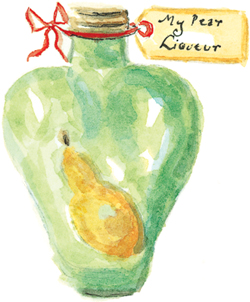
Unearth that stash of paper bags—you know, the one you’ve been hoarding for years—and turn the bags into planters. Spray or brush the inside of the bags with canola oil, let them air-dry, then fill them with soil and plant your seeds. Morning glories, moon vines, gourds, and many other plants don’t like to be transplanted, so when it’s time to transplant into your garden, leave the seedlings in the bags and plant them directly in the soil. The bags will eventually decompose as the plants take root.
Enclose young apples in small brown paper bags to protect them from pecking birds and hungry insects. When the fruits are still small, slit the bottom of a bag, slip the fruit in, and staple the top closed. Remove the bag a few days before harvesting so the apples can color.
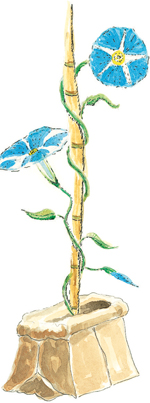
Make a hose guide with two terra-cotta pots. Place the bottom pot upside down at the corner of a flower bed that you want to protect from the dragging hose. Stack the other pot right side up on top of the first one. Push a dowel through the drainage holes to anchor the pots to the ground.
Alternatively, pound pairs of stakes a hose-width apart at each corner of the bed, and lay the hose between the stakes.
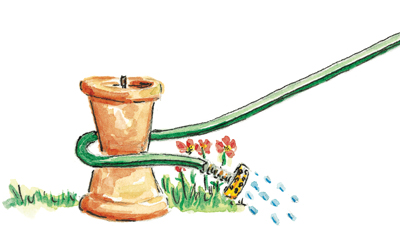
It worked for Victorian gardeners, and it still can’t be beat for blanching leeks, endive, and chicory. Make “collars” by slitting one side of a brown bag, then spray the interior with cooking oil. Turn the bag upside down over the plant, and bury it about 1 inch in the soil. Loosely tie at top and bottom with twine, and bank the soil against the bag to hold it in place.
Cut off the bottom of a plastic milk bottle, and slip the top (cloche-style) over a tender plant that needs protection from cold or animals. Remember to remove the cap so that heat will not build up during the day. You can use the bottom as a platform to keep melons, squash, and cucumbers off the ground.
Poke small drainage holes in a gallon milk container and bury it, with the neck exposed, beside a plant that requires extra irrigation. When you’re making your daily rounds, fill the container with water. Moisture will slowly leak through the holes and keep the plant hydrated.
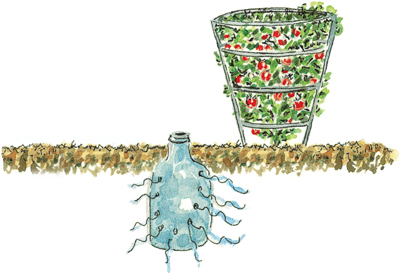
No water is wasted.
If you’re lucky, you might find a wooden splint market basket at a flea market or antique store. The tall sides and wheels make it a cinch to transport rakes, shovels, and spades. Some gardeners prefer old golf carts with all their pockets and pouches, but for charm you can’t improve on a basket cart.
Borrow your child’s little red wagon (the ones with the high wooden sides are nifty) for hauling heavy bags of soil, rocks, and tools.
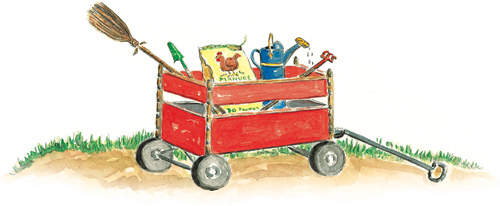
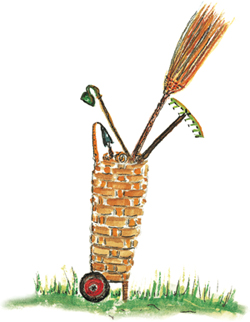
Wooden splint basket cart for hauling tools.
Use a holey old red wagon as a traveling “worm wagon.” Spread a piece of screen across the floor of the wagon so the worms don’t escape. Scoop in a few piles of worms and castings. Add soil and some juicy garbage, such as lettuce leaves, top with more soil, water thoroughly, and cover the whole creation with a piece of plywood. Move the wagon around your yard to areas that need the nutritious worm water that flows through the holes and onto the soil. And wherever you have containers that need toppings, just scoop out some wonderful wormy soil.
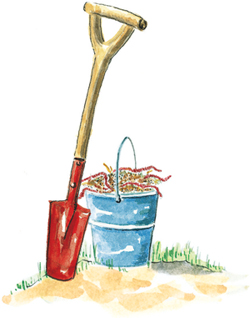
“I have several acres about my house, which I call my garden, and which a skillful gardener would not know what to call.”
—Joseph Addison, 1712
Snip a worn-out black or dark green hose into 3-foot sections and paint the hose with patterns to resemble snakeskins. Drape the hose over tree branches to keep squirrels, raccoons, and birds away from your fruit.
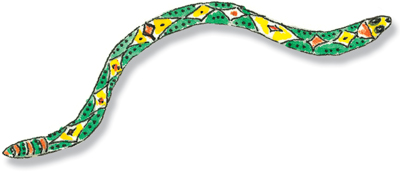
Surround a young heat-loving plant with a wall of water-filled bottles, which block the wind, warm the air around the plant, and radiate heat into the soil.
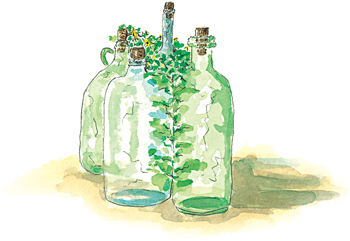
 Broad concrete finishing trowels, called Fresno trowels, are perfect for pressing newly sown seeds into a flower bed.
Broad concrete finishing trowels, called Fresno trowels, are perfect for pressing newly sown seeds into a flower bed.
 Glue a small mirror onto a yardstick to check the undersides of leaves for pests. Ideal for a gardener who has trouble bending over.
Glue a small mirror onto a yardstick to check the undersides of leaves for pests. Ideal for a gardener who has trouble bending over.
 You might think a bucket with holes in it is useless, but it’s not. Fill the bucket with water and hang it on a tree limb over a large terra-cotta saucer. The steady drip of water attracts songbirds that bathe in the saucer, and sweet woodruff and Corsican mint thrive in the moist areas surrounding it.
You might think a bucket with holes in it is useless, but it’s not. Fill the bucket with water and hang it on a tree limb over a large terra-cotta saucer. The steady drip of water attracts songbirds that bathe in the saucer, and sweet woodruff and Corsican mint thrive in the moist areas surrounding it.
 Turn your spade into an extra pair of hands. Whenever you need to direct a flow of water onto a portion of your garden, simply stick the tool into the soil and nestle your hose into the V-shaped notch where the handle begins.
Turn your spade into an extra pair of hands. Whenever you need to direct a flow of water onto a portion of your garden, simply stick the tool into the soil and nestle your hose into the V-shaped notch where the handle begins.
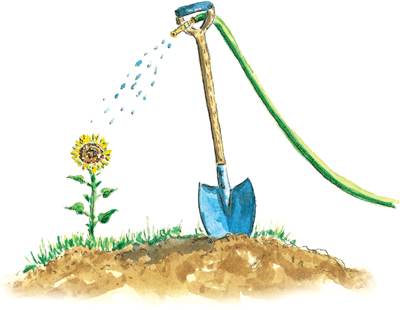
A spade makes a handy sprinkler stand.
 Tin cans with lids can be used as perches for melons and squash, and cans without lids serve as protective housing for cylindrical veggies such as zucchinis and cucumbers.
Tin cans with lids can be used as perches for melons and squash, and cans without lids serve as protective housing for cylindrical veggies such as zucchinis and cucumbers.
 Save old coffee cans and their plastic lids for yard cleanup. As you snip diseased leaves off plants (especially important for rust), place the leaves in the can, close the lid, and dispose of the leaves in the trash. To stop the spread of rust, don’t compost them. Rust spores travel through the air and enter the stomata in leaves.
Save old coffee cans and their plastic lids for yard cleanup. As you snip diseased leaves off plants (especially important for rust), place the leaves in the can, close the lid, and dispose of the leaves in the trash. To stop the spread of rust, don’t compost them. Rust spores travel through the air and enter the stomata in leaves.
 When you clean your pond, toss the nutrient-rich algae and scummy water onto the soil around your plants. It’s great fertilizer.
When you clean your pond, toss the nutrient-rich algae and scummy water onto the soil around your plants. It’s great fertilizer.
 When working around a staked plant, avoid accidental injury by placing a piece of cork on the tip of the stake.
When working around a staked plant, avoid accidental injury by placing a piece of cork on the tip of the stake.
 Follow the old-fashioned practice of using “backing boards” to reflect light onto vines and other sun-loving plants. Cover a board with aluminum foil or any reflective metal, prop it against a rock, and aim it toward sun worshippers such as tomatoes, peppers, or eggplants.
Follow the old-fashioned practice of using “backing boards” to reflect light onto vines and other sun-loving plants. Cover a board with aluminum foil or any reflective metal, prop it against a rock, and aim it toward sun worshippers such as tomatoes, peppers, or eggplants.
The tools of a gardener’s trade.
 Hasten the ripening of squash and melons by slicing flat stepping-stones or pieces of broken concrete underneath the produce. The stones trap heat and protect the crop from rotting on the ground.
Hasten the ripening of squash and melons by slicing flat stepping-stones or pieces of broken concrete underneath the produce. The stones trap heat and protect the crop from rotting on the ground.
 Control invasive horseradish plants, and coax them into putting down long, straight roots, by planting them in galvanized vent pipe. Set the pipe vertically up to the rim in a predug hole. Fill the pipe with good potting soil, slide in the horseradish, and tamp down the soil.
Control invasive horseradish plants, and coax them into putting down long, straight roots, by planting them in galvanized vent pipe. Set the pipe vertically up to the rim in a predug hole. Fill the pipe with good potting soil, slide in the horseradish, and tamp down the soil.
